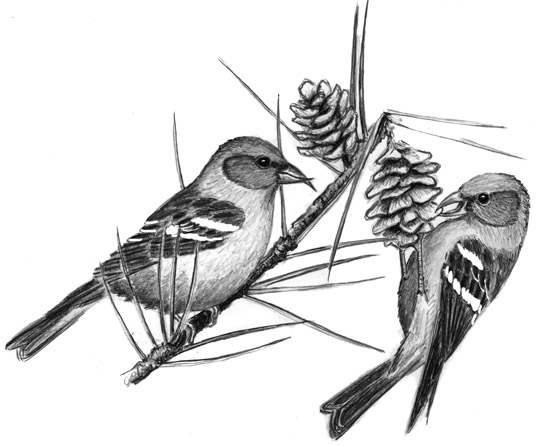
Dear Bird Folks,
It seems I can’t turn on the news or pick up a newspaper without seeing a story about birds they are calling “crossbills.” Is this really a big deal or is the news just slow lately?
– Stewart, Yarmouth, MA
It’s not slow news, Stu,
How could you think the news is slow? Look at all the exciting news out there. There are the endless stories about casinos (for some reason). Then there is the biweekly wind farm story, followed up by another casino story. Oh, I see what you mean. You’re right. Ever since the bear left us last spring, the local news has been a little thin and ridiculously repetitive. Even the shark stories have run out of steam. It’s nice that they ran a story or two about crossbills. I like when they write about birds that people aren’t complaining about. (I’m talking to you, plovers.)
The media is right to be writing stories about crossbills. Ornithologically speaking, this is a very big deal. In the history of record-keeping, there has never been this many crossbills on Cape Cod. Ever! Not even close. Back in 1930 there were 204 White-winged Crossbills counted on the Cape. Since then very few of these birds have found their way here, but that all changed this year. Last week four hundred crossbills were spotted near the Marconi area in Wellfleet. Another 300 hundred were reported on Nantucket and more were photographed at in Harwich. Crossbill reports are coming in from all over. Why are there so many? My feeling is the birds flew in just to read more stories about the casinos and the wind farm, but I could be wrong.
Only slightly larger than a House Sparrow, crossbills are finches that typically live in northern Canada. Earlier in the fall I wrote about a wave of Red-breasted Nuthatches and Pine Siskins being seen in our area. Seeing nuthatches and siskins around here is not unusual, but seeing so many of them (thousands) is a bit abnormal. Most of the siskins and many of the nuthatches have since moved on, but now they have been replaced by crossbills. All of these invading birds have two things in common: They are from Canada and they are hungry. There is a major food shortage in Canada this year. (No, I’m not talking about bacon or donuts, so relax.) Why no food? This year’s drought could be the problem or it could simply be due to an odd growing cycle. But whatever the reason, the northern seed crop has failed. This has caused the birds in the north to move south by the millions in hopes of finding some grub. In this case the grub is in the form of pinecones. The same pinecones that we use for Christmas decorations or smear with peanut butter to make a poor man’s bird feeder, the crossbills depend upon for survival.
Of course, crossbills don’t actually eat the entire pinecone; they only eat the seeds hidden underneath the protective pinecone scales. Most other birds ignore pinecones because they don’t have the tools needed to breakthrough the scales, but that’s where the crossbill’s “crossbill” comes into play. Looking like a bird in need of some serious orthodontic work, the bird’s lower beak (bill, mandible, jaw) is bent to one side. Sometimes the lower beak is bent to the right and sometimes it’s bent to the left, but it’s always bent and it’s always creepy-looking. Creepy-looking or not, the crossbills’ beaks are specialized tools that allow these birds access to a food supply that most other birds can’t exploit. A hungry crossbill simply jams its odd bill under one of the cone’s scales, pries open the scale with a twist of its head and instantly removes the seed with its tongue. While this feeding method appears to be awkward, the birds are extremely good at it. A single crossbill may extract as many as 3,000 pinecone seeds in a day and yet it drops very few. Their efficiency and neatness amazes me, especially since I can’t manage to eat a single ear of corn on the cob without looking like an explosion in a grain silo when I’m done.
Unfortunately for the birds, their beaks have two serious drawbacks. First of all, the beaks are so specialized that the birds have trouble eating other kinds of food. They’ll struggle to get enough to eat if they can’t find a steady supply of pinecones. Secondly, and rather sadly, their peculiar beaks make it hard for a crossbill couple to kiss. One false move and the couple could be locked together for hours, like teenagers with braces.
Because crossbills usually live in remote locations, they appear to have little fear of humans. Several customers have reported flocks of these birds descending on them. Yes, actually “on” them. One lady told me that the birds landed on the branches above her head and on the ground around her feet. She said some of the birds proceeded to stroll right up to her, walked across her feet and continued on their way. How cool is that?
So far I’ve had no reports of crossbills on bird feeders, but that could change if the natural food supply becomes exhausted. So keep an eye on your feeders, and your birdbaths, too. In the meantime, Stewart, check out every spruce or pitch pine you see. If the tree has pinecones, look carefully. This could be your chance to see some of these unique birds. And if you get really lucky, an entire flock of them might land at your feet. If that happens, relax. Crossbills are totally harmless, so there is no need to be afraid. But just don’t try to kiss one. You could be stuck for hours.